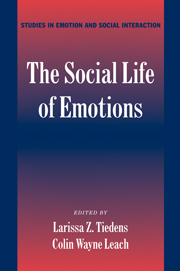Book contents
- Frontmatter
- Contents
- Acknowledgements
- List of Contributors
- The Social Life of Emotions
- Introduction: A World of Emotion
- PART I THE INTERPERSONAL CONTEXT
- PART II THE INTRAGROUP CONTEXT
- 6 Emotional Contagion
- 7 The Emotional Convergence Hypothesis
- 8 Emotional Variation in Work Groups
- 9 Inside the Heart of Emotion: On Culture and Relational Concerns
- 10 Objectification Theory and Emotions
- PART III THE INTERGROUP CONTEXT
- Index
- References
8 - Emotional Variation in Work Groups
Causes and Performance Consequences
Published online by Cambridge University Press: 01 April 2011
- Frontmatter
- Contents
- Acknowledgements
- List of Contributors
- The Social Life of Emotions
- Introduction: A World of Emotion
- PART I THE INTERPERSONAL CONTEXT
- PART II THE INTRAGROUP CONTEXT
- 6 Emotional Contagion
- 7 The Emotional Convergence Hypothesis
- 8 Emotional Variation in Work Groups
- 9 Inside the Heart of Emotion: On Culture and Relational Concerns
- 10 Objectification Theory and Emotions
- PART III THE INTERGROUP CONTEXT
- Index
- References
Summary
The human tendency toward homogeneity is a cornerstone of social psychology. Classic studies going back to at least Asch (1955, 1956) and Sherif (1936) suggest that, when interacting with others, variance in human thought and action disappears as people conform to other group members and group norms. Convergence is considered to be a primary consequence of social interaction and group life. In fact, group life often becomes synonymous with uniformity and conformity among members. So, it is not surprising that research on emotion as a group-level construct focuses on homogeneity and on the mechanisms that propel group members to share emotional reactions (see Anderson & Keltner, this volume; Barsade & Gibson, 1998; Bartel & Saavedra, 2000; Hatfield, Cacioppo, & Rapson, 1994; Hatfield & Rapson, this volume).
Although group dynamics researchers have documented powerful pressures that drive out variance, variance within groups has also been a persistent, if less frequent, theme as well (Cartwright & Zander, 1960; Schein, 1965). Groups do not transform members into clones: Variance persists in even the most homogenous groups, and such variation can have important consequences. Some modern research on group cognition does imply the value of examining variation in groups. The widely studied notion of transactive memory, for example, is predicated on the heterogeneity of information held by group members – that group members know and remember different things (e.g., Liang, Moreland, & Argote, 1995; Moreland, 1999; Wegner, 1986).
- Type
- Chapter
- Information
- The Social Life of Emotions , pp. 164 - 186Publisher: Cambridge University PressPrint publication year: 2004
References
- 19
- Cited by



